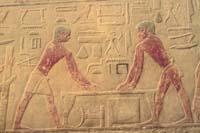24 hours, 60 minutes and 60 seconds

At present, the most used decimal numbering system. Possibly, this system arises from the ease of having the fingers of the hands. However, the first civilizations that divided the day into smaller parts used the twelfth and sexagesimal system.
For many historians, the first civilization that divided the day of the Egyptians into smaller parts. For this purpose, they used sundials. The first solar clocks were simple poles placed standing on the ground; the length of the shade and its direction indicated the time. a.C. By 1500, the Egyptians developed a more advanced sundial. By means of a T-shaped bar placed on the ground, the distance between sunrise and evening was divided into twelve parts.
Days and nights of 12 hours

In fact, the Egyptians used the twelfth numbering system, perhaps because the year has twelve periods of moon, or perhaps because we have in our hands a dozen fingerprints (removing the thumb, three joints per finger). Yes, although all the hours it had every day were of the same duration, the duration of the hour varied greatly according to the time of the year: the summer hours were much longer than the winter hours.
On the other hand, at night solar watches are useless. The Egyptians distributed the night time based on the moment when certain stars appeared in the sky, looking for it to twelve stars. They also used clepsidras or water clocks at night. They were probably the most accurate watches of antiquity, and sometimes the traces they made to divide the night into twelve parts are clearly seen.
The next step in measuring time was the creation of the twenty-four hour day concept. Greek mathematician Hiparko proposed to divide the day into twenty-four hours and that the hours always have the same duration. However, people continued to use for centuries variable hours of duration according to the time of year (XIV. Until in the twentieth century mechanical watches were built in Europe).
Minutes and seconds

And the minutes and seconds, where do they come from? For the Greeks invented them to designate the divisions of the latitudinal system, and the system was sexagesimal. However, minutes and seconds were not used until much later to indicate the time distributions. Tell us: first watches with minutes. They appeared at the end of the twentieth century. Until then it did not make much sense to divide the time into minutes. In addition, at first, if the hours are divided, twelve parts were made and not sixty.
Therefore, the time distribution system is the heir of ancient civilizations. Advances in science have helped to define the parts of time well. For example, the international system of units defined the second as part of a solar day, then related it to the tropical year and redefined it in 1967: the second was the energy transition of the cesium atom 9.192.632.770. It was the atomic measurement portal (UTC) of the time currently used.
The atomic measure is extremely accurate, but does not exactly match the astronomical, and for its adaptation they have to make small traps. For example, there are minutes (eight in ten years) that take 61 seconds.
Published in 7K.
Buletina
Bidali zure helbide elektronikoa eta jaso asteroko buletina zure sarrera-ontzian











